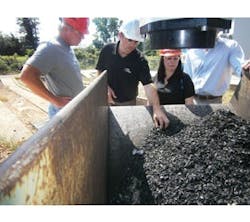From Waste to Power to Profit
Almost all municipalities share the same dilemma: what to do with wastewater treatment sludge, tree trimmings and discarded tires. For years, the answer has been to load them up and take them to a landfill. The transportation bid may go to a trucking company with a fleet that may not be clean and green but belching contaminants every time drivers push the accelerator. It is a costly necessity of running a city government, and one that residents expect.
It is costly for the landfill as well. What happens when the landfill is full and can no longer accept waste? Transportation costs, and in some cases tipping costs, rise as towns scramble to find the next nearest landfill that will accept this waste. Some landfill management firms have reported that the cost and value of their air space alone is sometimes more than half the tipping fee. Gasification may be key to solving these issues faced by municipalities/companies while extending the life of landfills. In light of these concerns, David Gordon, mayor of Covington, Tenn., decided to do something about his city’s waste stream problem.
Busting the Gasification Myth
It has been stated in the past that gasification does not work, but technologies such as downdraft gasification systems can bust that myth. Vetted, proven and patented technologies lie at the heart of the plant that is operating daily for Covington, a city of 9,000 residents located in Tipton County.
PHG Energy’s technology employs a process in which waste materials are cleanly converted to a fuel gas with combustion properties similar to natural gas. No trees need to be harvested for this process. Feed stocks are waste streams (such as sludge or discarded tires) or purpose-grown vegetation. The fuel can be used for thermal applications, kilns or boilers, or electricity generation.
Delivering Returns on Investment
Gordon, a veterinarian by trade, always has been active in his community. Because of his love of science, he dedicated his career to the health and welfare of livestock and pets. One day, he decided to run for mayor and was elected to office.
As mayor, he became all too aware of what it takes to keep a city running. He observed trucks moving up and down the highway—all related to the removal of the city’s sludge waste and tree trimmings, costing the city government money—and he began research to see what could be done.
Gordon learned of gasification technology, then partnered with PHG Energy to build and design a gasification plant. The electricity the plant generates is used to offset electrical costs at the city’s wastewater treatment plant next door, which has a capacity of approximately 1 million gal per day.
PHG Energy, based in Nashville, Tenn., was formed in 2010 by the owners of Thompson Machinery to develop, manufacture and install downdraft gasification systems. The technology employs a flameless thermo-chemical process to convert waste materials or renewable biomass fuel gas.
Gordon saw immediate savings when the plant went online. In terms of revenue, the city saved money by eliminating the cost of transporting and landfilling 360 tons of biomass monthly. In addition, 125 kW of electricity are used to sustain the needs of the gasification plant and offset the utility bill at the wastewater treatment plant next door.
The system utilizes PHG’s proprietary 12 ton-per-day-capacity downdraft gasifier to supply approximately 6 million BTUs of producer gas per hour as the central technology.
The plant gave Covington positive cash flow from day one as thousands of dollars were freed up for other city needs. Over the life of the project, more than $3.5 million will be made available. The city’s payback period is essentially nullified by long-term bond financing to cover the cost of the plant.
The Covington system design is modular and can be upgraded to accommodate larger municipal or industrial facilities. Other projects in the development pipeline are showing payback periods of three to five years. This design also lends itself to overall low maintenance.
The cost summary for the Covington plant was as follows:
- Total cost of the plant: $2.5 million;
- Grant from the Tennessee Department of Environment and Conservation: $250,000; and
- Financing from a 20-year Tennessee municipal bond fund.
Covington’s clean energy system will prevent the release of 425 tons of carbon into the atmosphere each year by reducing energy usage related to wastewater treatment, as well as fossil fuels used in waste disposal transportation. According to information provided by the U.S. Environmental Protection Agency, the carbon reduction is equivalent to greenhouse gas emissions expected annually from 75 automobiles, or the carbon dioxide emissions created through energy use in more than 33 homes.
Fully Expandable & Adaptable Technology
The design has been vetted by more than 45,000 hours of commercial production use. It allows the city to dispose of 10 tons of urban wood waste and two tons of sewer sludge every day, or 360 tons per month. The system functions and commands are handled from a central computer control room, and the entire plant can be monitored from offsite locations.
As more technology develops, this plant is fully expandable and adaptable to new feedstocks from other waste streams without rebuilding the plant. As a result of the current cost savings, Gordon plans to improve city parks and services.
Download: Here
